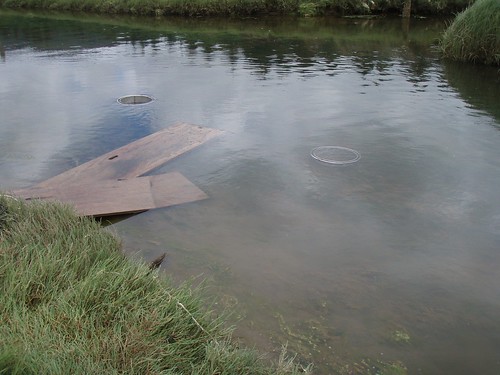It has been another action packed week on the nutrient uptake project! The pictures below show the onslaught of the tide as I work under pressure to get the samples taken. Inside the chamber is a relatively controlled environment with artificial water and carefully measured nutrient concentrations, so an invasion by the raging sea would not be conducive for reliable results.
 In this particular instance we had to shorten our time intervals for sampling so we could get what we wanted before what happened in the second picture. It was great fun sticking my hand in to collect the sea grass from the bottom, especially with all the sediment swirling up so I couldn’t see what I was doing.
In this particular instance we had to shorten our time intervals for sampling so we could get what we wanted before what happened in the second picture. It was great fun sticking my hand in to collect the sea grass from the bottom, especially with all the sediment swirling up so I couldn’t see what I was doing.
In the midst all this fieldwork we also spend some time in the lab. It is always strange to walk inside after a day in the field. Going from sun and mud to fluorescent lights and shiny tiled floors shocks me a little. Last week I learned a new instrument, the Trilogy. Because of the strange results we were finding in our nitrogen concentrations over time using the ISUS instrument, we decided to try this new instrument which measures the same thing in a slightly different way. The Trilogy is situated in a room with a fume hood and no windows and we wear white lab coats and gloves, quite the contrast to the field atmosphere. We also cannot engage in any horseplay as we are dealing with a carcinogenic nitrogen reducing agent in the form of a powder. One sneeze will kill you. Our results still came out funny but a different kind of funny, so we’re not sure what to do about that yet.
Another activity we carry out in the lab is plant biomass sampling. In the field we cut down all the plants in a chamber and in the lab we sort out dead and live plants to be dried and massed to determine percentage live plant mass. This involves untangling each individual blade of grass, separating brown from green. Each chamber takes about an hour to do. If this fact wasn’t overwhelming already, today we learned that the contractors who are working on the project with us do not have this part of the project in their contract…so only us interns are allowed to work on it. Such is the nature of government-contractor politics! And there are three of us interns and thus no time to get this done. So we will freeze the plants until an unspecified date. I am relieved.
This past weekend we had our mid-summer check-in with the Oregon Sea Grant. It was great to hear about all the other interns’ projects. I also worked in the Sea Grant booth at the DaVinci Days and showed many kids about the dangers of pollutants to the watershed. The pollutants for our demo were Kool-Aid, soy sauce, baking soda, and cocoa powder and spray bottles for rain. The kids were fascinated by the model of the town and all the flowing water. I enjoyed attempting to make an impression on young minds.
This week we do more field work. Who knows what the week will bring? There is always something new and interesting that happens. Like last Thursday we left one of the ~60 lb weights sitting in a mudflat in Nestucca, so today we had to use a regular old brick. We’ll have to venture back there with the hovercraft soon to retrieve it…hopefully the ground will not have swallowed it up by then.


